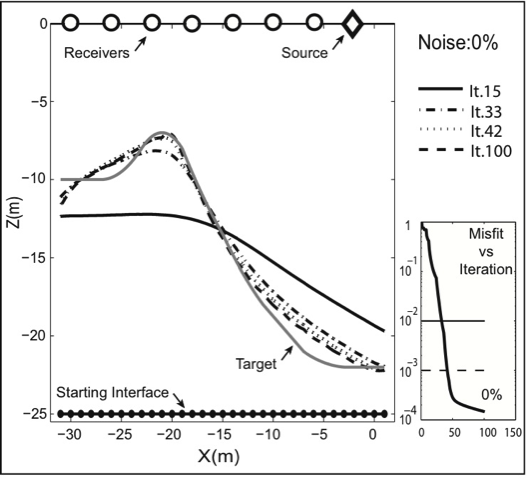An interdisciplinary Georgia Tech team is leading an effort to formulate an innovative class of computational models for a wide range of inverse problems in geosciences with a focus on subsurface characterization via surface wave testing. The synergistic research team includes: Principal Investigator (PI) Francesco Fedele, assistant professor in the School of Civil and ENvironmental Engineering, and co-PIs Glenn Rix, professor and group leader of Geosystems Engineering and Anthony Yezzi, professor in Electrical and Computer Engineering (ECE).
The recognition and geometric characterization of geological bodies and tectonic structures in thesubsoil is a crucial issue in many fields of both Earth Sciences and Engineering and particularly as concerns seismic hazard assessment. Indeed, based on a good geological knowledge and reliable reconstruction of the subsoil, it could be possible, for example, at a large scale (1-0.1 km), like a sedimentary basin or an alluvial valley, to predict local seismic effects and perform a well refined micro-zonation or at a small scale (10 m), locate with sufficient precision a fault trace and provide basic information for planning anti-seismic buildings.

The research team realized that the further development and use of surface wave methods in geotechnical engineering is limited by the lack of robust, computationally efficient algorithms that would enable the use of surface wave methods in more realistic 2D and 3D media. To fill the gap, the research team proposes to formulate an innovative class of computational models that will be referred to as BEM Adjoint-based Active Surfaces through a multidisciplinary approach in physical, mathematical, and computational modeling. This will require a synergistic combination of independent computational methodologies – Boundary Element Methods (BEM) and geometric active contours/surfaces - that have matured in isolation from each other across differing scientific and engineering disciplines.

In particular, BEM techniques have been applied in solid mechanics, heat transfer, optics and wave propagation in problems where the medium is piecewise homogeneous with arbitrarily complex shapes. This allows to explicitly modeling the interfaces between sharp transitions in material properties. On the other hand, geometric active surfaces have been successfully applied to problems in image segmentation such as, for example, to optimally outline the white-matter/gray-matter boundary of the cerebral cortex.

A first formulation of the computational model for 1D laterally varying geometries was developed by Dr. Samuel Bignardi of the University of Ferrara while visiting Georgia Tech as a graduate student in 2009-10. During this period, Dr. Bignardi worked under the mentorship of Drs. Fedele, Yezzi and Rix. Dr. Fedele served as Bignardi's co-advisor with Dr. Giovanni Santarato, his italian advisor.
The figure to the left shows results from Bignardi's doctoral thesis: a laterally varying subsurface consisting of a non-flat tw-layer geometry and a typical instrumentation setup for surface wave testing. Equi-spaced receivers will acquire local soil accelerations due to a generated seismic source. From this image, one can appreciate the ability of the inversion algorithm to provide good estimates of the laterally varying interface separating the two layers.
Thus, the synergy of BEM and active surfaces will empower to directly extracting useful geometric knowledge from vast amounts of raw collected data in applications (such as surface wave testing) where the raw data itself is not suitable for effective visualization and human interpretation. For many geotechnical problems, this piecewise homogeneous modeling of materials with arbitrarily complex shapes to explicitly model the interfaces between sharp transitions in material properties constitutes a revolutionary change in reconstructing unseen geometric layer boundaries directly from the raw measurements, where the standard procedure is to first transform the raw collected data into more intuitive volumetric data (cross-sectional images for example) from which geometric features (such as strata or inclusion boundaries) can then be extracted afterward via follow up image processing methods.

(Shown left to right: (a) original bone image; (b) traditional tomographic reconstruction from partial measurements (only 9 projection images out of 256); (c) reconstruction from same partial measurements using geometric layer modeling via active surfaces; (d) original brain image (e) reconstruction from partial measurements using geometric layer modeling via active surfaces.)
The proposed approach can also be applied to a vast number of other geometric inverse problems with partial differential equation (PDE) constraints and it would open the door to an immense class of PDE-constrained inverse problems with geometric unknowns in other scientific fields.
RELATED LINKS:
Dr. Francesco Fedele, CEE assistant professor at Georgia Tech Savannah: http://www.ce.gatech.edu/people/faculty/511/overview
Dr. Glenn Rix, CEE professor and research group leader for Geosystems Engineering: http://www.ce.gatech.edu/people/faculty/541/overview
Dr. Anthony Yezzi, ECE professor and director of the Laboratory of Computational Computer Vision: http://www.ece.gatech.edu/research/labs/lccv/people.html
